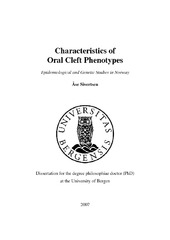| dc.description.abstract | The surgical treatment of oral clefts in Norway has been centralized to two plastic surgery departments that have had well-organized data sets on their cleft patients since the early 1960’s. Since 1967, it has been compulsory to register all births and congenital defects in the Medical Birth Registry of Norway (MBRN). A comprehensive classification of the cleft cases was required in order to make better use of the information in these data sets for clinical studies and epidemiological and genetic research. We worked out a modification of Kernahan’s striped-Y diagram and of Schwartz’s three-digit numerical coding in order to classify the morphological variation in oral clefts based on nine anatomical focal areas in the primary and secondary palate, anterior and posterior to the incisive foramen. The classification is well suited to providing a population-based reference for 63 common and rare cleft variants and to characterizing the three commonly used categories of clefts (CLO cleft lip only, CLP cleft lip and palate, CPO cleft palate only). This classification is the basis for all our papers I-IV. When we present the ascertainment of oral clefts in the MBRN and when estimating the familial risk of cleft recurrence we relate our analyses to this classification. Moreover, we demonstrate the use of molecular genetic analyses to characterize two subgroups of cases. Virtually all patients operated for oral clefts in Norway from 1967 to 1998 (3616 cases) are included in our clinical data. The distribution of 63 subgroups of clefts in the population (1.9 million births) as a whole is presented, and stratified by the baby’s sex and the presence of accompanying malformations (Paper I). Clefts of the primary or secondary palate were more severe when both types of clefts are present. The more severe the cleft lip, the more likely that the baby had an accompanying cleft palate. Girls were more likely to have severe clefts, as were cases that had other birth defects. Although cleft lip was more frequent on the left side, clefts were not more severe on the left side. Based on the completeness of our clinical data we calculated the proportion of clinically verified cases reported to the MBRN (Paper II). We described the morphological characteristics of the reported and non-reported cases. The registration was far better when cleft palate was accompanied by a cleft lip. 83% of CLO-cases, 94% of CLP-cases and 57% of CPO-cases were reported to the Registry. The ascertainment was also clearly related to the severity of the defect. The substantially reduced reporting for mild clefts is essential to understanding the reliability and use of registry data for disease surveillance and research. The large proportion of cleft palate cases not reported indicates that better routines are required for the detection of cleft palate at the neonatal clinical examination. We also explored whether cleft cases with severe cleft morphology have a higher risk of familial recurrence than the mild cases (Paper III). A linkage of clinical data and data from the MBRN (1967 to 2001) allowed us to combine high-quality clinical information on cleft morphology with virtually-complete ascertainment of biological family members for the whole country over a 35-year period. Index cleft cases with non-cleft birth defects were not included when we estimated the recurrence risk of clefts from parent to child and in fullsibships. We found no higher risk of clefts in children of affected mothers than in children of affected fathers. This indicates no major effect of maternal genes and the absence of sexspecific genomic imprinting. The overall risk of clefts was similar in sibships and from parent to child and so was cleft type specificity in the recurrence for CLO, CLP and CPO. The recurrence risks of cleft lip cases were similar regardless of whether cleft palate was present. The recurrence risk of CPO was 56-fold and significantly different from the recurrence risk of CL (31-fold). We found no effect of cleft severity on recurrence risk. The multifactorial threshold model as a model of inheritance of oral clefts is questioned by these findings and indicates that severity is independent of genes predisposing for oral clefting. As a demonstration of molecular characterization of clefts we studied the prevalence of duplications and deletions in the 22q11.2 region among newborns with open cleft palate without cleft lip, two of the subgroups within the CPO category (Paper IV). We selected the study cases (191 cases) from a larger population-based case-control study of oral clefts (573 cases) in Norway (1996-2001). DNA was available from 174 cases and the DNA copy number was analyzed using multiplex ligation-dependent probe amplification technique (MLPA). We found no 22q11.2 duplications and three cases with 22q11.2 deletions, corresponding to a prevalence of 1.8 % (1of 57). All three del22q11-syndrome cases also had congenital heart defects. They represent one-third of the ten babies with congenital heart malformations in our study population. We conclude that neither del22q11 nor dup22q11 testing is warranted in babies when open cleft palate is the only indication. | en_US |
